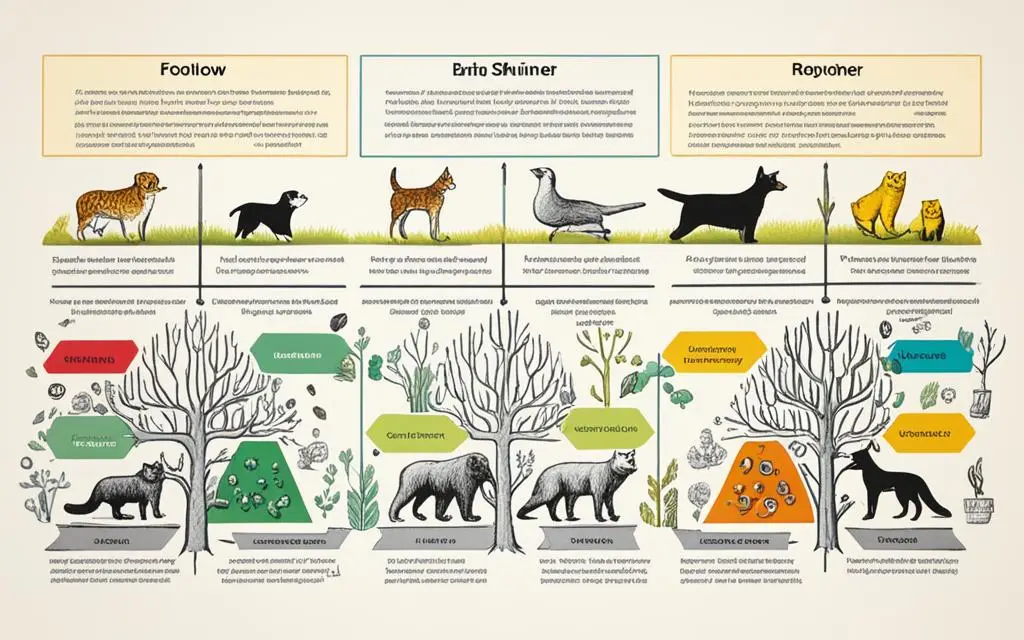Have you ever wondered why certain behaviors become ingrained in our daily lives, while others seem to fizzle out? Why is it sometimes difficult to break bad habits or establish new ones? The answer lies in the powerful concept of reinforcement theory.
Reinforcement theory suggests that our behaviors are shaped by their consequences. Think about it – every action we take has some sort of outcome, whether positive or negative. These outcomes, or consequences, play a crucial role in determining the likelihood of us repeating or abandoning a behavior.
Imagine a scenario where you teach your dog a new trick. Initially, they may not know what to do, but as you provide positive reinforcement, such as praise and treats, they start to associate performing the trick with receiving rewards. Over time, their behavior becomes increasingly shaped by the desire to attain those rewards. The same principle applies to humans – our behaviors can be strengthened or weakened based on the outcomes they produce.
By understanding and applying reinforcement theory, you can unlock the key to modifying and shaping behavior to achieve desired outcomes. Whether you want to break a bad habit, encourage positive behavior in others, or motivate yourself to reach your goals, reinforcement theory provides a powerful framework to help you succeed.
Key Takeaways:
- Reinforcement theory suggests that behaviors are shaped by their consequences.
- Positive reinforcement involves adding desirable outcomes to increase the likelihood of a behavior.
- Negative reinforcement involves removing undesirable outcomes to increase the likelihood of a behavior.
- Understanding and applying reinforcement theory can help in modifying and shaping behavior to achieve desired outcomes.
- Reinforcement theory applies to both humans and animals and can be used in various settings.
The Origins and Evolution of Reinforcement Theory
Reinforcement theory, a fundamental principle in understanding behavior, has its roots in behaviorism. Behaviorism is a psychological approach that focuses on studying observable behaviors rather than internal mental processes. This school of thought emerged in the early 20th century, challenging the prevailing emphasis on introspection and subjective experience in psychology.
A prominent figure in the development of reinforcement theory is B.F. Skinner. Skinner was an influential behaviorist who conducted extensive research on operant conditioning, which is a form of learning that involves the manipulation of consequences to shape behavior. He believed that behavior can be systematically modified through the use of reinforcement and punishment, with reinforcement being more effective in promoting behavioral change than punishment.

Another influential concept in behaviorism is classical conditioning, which was pioneered by Ivan Pavlov. Classical conditioning examines the association between stimuli and involuntary responses. This approach demonstrated that by pairing a neutral stimulus with a naturally occurring response, the neutral stimulus could elicit the same response over time. This groundbreaking research provided further evidence of the importance of external factors in shaping behavior.
Over time, behaviorism shifted the focus from internal drives to observable behaviors and the consequences that drive them. This transition led to the development of reinforcement theory, which emphasizes the role of consequences in influencing behavior. Reinforcement theory suggests that behaviors can be strengthened or weakened through the use of positive or negative consequences. By understanding the principles of reinforcement theory, individuals can effectively modify and shape behavior to achieve desired outcomes.
Key Components of Reinforcement Theory
The key components of reinforcement theory play a crucial role in understanding and applying this psychological principle to behavior modification. By leveraging these components effectively, individuals can shape and reinforce desired behaviors while discouraging undesirable ones.
Reinforcers:
Reinforcers are stimuli or events that follow a behavior and increase the likelihood of that behavior recurring in the future. They serve as motivators and rewards, reinforcing the connection between a specific behavior and its consequences. Reinforcers can be classified into two main categories:
- Positive Reinforcement: Positive reinforcement involves the presentation of desirable outcomes or rewards following a behavior. This could include praise, recognition, monetary incentives, or any other form of positive consequence. By associating the behavior with positive outcomes, individuals are more likely to repeat the behavior.
- Negative Reinforcement: Negative reinforcement involves the removal of aversive or undesirable outcomes following a behavior. This can include alleviating pain, eliminating an unpleasant task, or any other form of removing undesired stimuli. By removing negative consequences, individuals are motivated to engage in the desired behavior to avoid the aversive outcomes.
Punishment:
Punishment is an aversive consequence applied following a behavior with the intent to decrease its frequency. It involves the application of penalties or negative consequences to discourage undesirable behaviors. Punishment can include reprimands, fines, loss of privileges, or any other form of negative consequence that serves as a deterrent. While punishment can be effective in reducing undesired behaviors, its use should be carefully considered to avoid unintended negative consequences.
Overall, understanding and utilizing the key components of reinforcement theory, including reinforcers and punishment, can empower individuals to modify behavior effectively for positive outcomes. By employing appropriate reinforcement strategies, practitioners can encourage desirable behaviors through positive reinforcement while discouraging undesirable ones through appropriate punishment.

Applying Reinforcement Theory in Various Settings
Reinforcement theory is a versatile psychological principle that can be applied in various settings to modify behavior. By understanding how reinforcement affects behavior, individuals and organizations can strategically shape and modify behaviors to achieve desired outcomes. Let’s explore how reinforcement theory can be practically applied in three different contexts: the workplace, educational approaches, and user experience and design.
Behavior Modification in the Workplace
In the workplace, reinforcement theory can be used to motivate employees, reinforce desired behaviors, and discourage undesirable behaviors. By applying positive reinforcement, such as recognition for a job well done or rewards for achieving goals, employers can encourage employees to exhibit desired behaviors consistently. Similarly, negative reinforcement, such as removing unpreferred tasks or reducing workload, can reinforce behaviors that contribute to improved performance and productivity. Additionally, punishment, in the form of corrective actions or penalties, can deter employees from engaging in undesired behaviors or violating company policies.
Educational Approaches and Reinforcement
Reinforcement theory is also applicable in educational settings, as it can enhance learning outcomes and promote positive student behaviors. Teachers can utilize positive reinforcement strategies, such as praise, rewards, and privileges, to encourage active participation, academic progress, and exemplary behavior. Conversely, negative reinforcement techniques, such as temporarily removing a challenging task or reducing homework, can motivate students to overcome obstacles and engage more effectively with the learning process. By consistently reinforcing positive behaviors and providing constructive feedback, educators can create a conducive environment for academic growth and success.
Impact on User Experience and Design
Reinforcement theory’s insights into behavior modification also extend to the realm of user experience and design. When designing products, services, or interfaces, understanding how reinforcement works can help create more engaging and user-friendly experiences. By employing persuasive design techniques, such as incorporating visually appealing rewards or progress indicators, designers can reinforce desired user behaviors and motivate continued usage. Providing positive reinforcement cues, such as notifications or badges, can also foster a sense of achievement and drive user engagement. In this way, reinforcement theory contributes to the development of more effective and enjoyable user experiences.
Overall, reinforcement theory offers practical applications for modifying behavior in different settings. Whether in the workplace, education, or user experience design, the principles of reinforcement theory can be leveraged to motivate, shape, and guide behavior towards desired outcomes.

Techniques and Strategies for Effective Reinforcement
When it comes to reinforcement, employing a variety of techniques and strategies is essential for effectively facilitating behavior change. By utilizing these techniques, you can maximize the effectiveness of reinforcement and achieve your desired outcomes. Here are some key techniques and strategies to consider:
- Identifying and using appropriate reinforcers: It is important to find and utilize reinforcers that are meaningful and desirable to the individual. This could include rewards such as praise, recognition, tangible rewards, or privileges.
- Setting clear expectations and goals: Clearly communicate the desired behaviors and set specific goals that individuals can work towards. This provides a clear framework for what behaviors will be reinforced and helps individuals understand what is expected of them.
- Providing timely and consistent feedback: Feedback is crucial for reinforcing desired behaviors. Provide feedback as soon as possible after the behavior occurs, and ensure that it is consistent and aligned with the desired outcomes. This helps individuals understand what behaviors are being reinforced and encourages them to continue those behaviors.
- Adjusting reinforcement schedules: Different reinforcement schedules can have different effects on behavior. Consider adjusting reinforcement schedules to maintain motivation and prevent habituation. This could include using variable reinforcement schedules, where rewards are given intermittently and unpredictably.
Remember, it is important to consider individual differences, preferences, and motivations when designing and implementing reinforcement strategies. What may be reinforcing for one person may not work for another. By tailoring your strategies to the individual, you can effectively reinforce behavior and promote lasting behavior change.
Now that you understand the key techniques and strategies for effective reinforcement, you can apply them in various settings to facilitate behavior change. Whether in the workplace, educational settings, or even in designing user experiences, these techniques and strategies can help you achieve your desired outcomes and promote positive behavior change.
Reinforcement Schedules and Their Role in Shaping Behavior
Reinforcement schedules are essential in shaping behavior and understanding how different types of schedules can influence behavior patterns. By employing various reinforcement strategies, individuals can effectively modify and shape behaviors to achieve desired outcomes.
Continuous vs. Intermittent Reinforcement
Continuous reinforcement involves reinforcing a behavior every time it occurs. This type of reinforcement is highly effective for establishing new behaviors and is often used in initial stages of behavior modification programs. However, maintaining continuous reinforcement can be impractical in certain situations and may lead to dependency on constant reinforcement.
Intermittent reinforcement, on the other hand, involves delivering rewards on an occasional and unpredictable basis. This reinforcement schedule can promote sustained efforts and behavior change. It is believed to create strong and enduring behaviors as individuals become more motivated to engage in the desired behavior in hopes of receiving a reward, even though they are unsure when it will be given.
Fixed-Interval and Variable-Interval Schedules
In fixed-interval reinforcement schedules, reinforcement is provided at a fixed time interval. For example, an employee may receive a bonus every month for meeting certain sales targets. This type of reinforcement schedule tends to produce a pattern of behavior where individuals increase their efforts as the reinforcement time approaches.
Variable-interval reinforcement schedules involve delivering reinforcement at varying time intervals. An example of this schedule would be a supervisor providing praise to their employees at unpredictable intervals throughout the workday. This reinforcement schedule can generate a consistent level of engagement and effort since individuals do not know exactly when the reinforcement will occur.
Fixed-Ratio and Variable-Ratio Reinforcement
Fixed-ratio reinforcement schedules provide reinforcement after a specific number of responses. For instance, a salesperson may earn a commission for every fifth sale made. This reinforcement schedule tends to produce a high response rate, with individuals working more rapidly to achieve the desired number of responses.
Variable-ratio reinforcement schedules deliver reinforcement after an unpredictable number of responses. An example of this schedule is a slot machine at a casino that pays out winnings on a variable basis. This reinforcement schedule tends to produce high and consistent levels of responding as individuals are motivated to keep engaging in the behavior due to the uncertainty of when the next reinforcement will occur.
To summarize, reinforcement schedules play a significant role in shaping behavior. Continuous and intermittent reinforcement have different effects on establishing and maintaining behaviors. Fixed-interval, variable-interval, fixed-ratio, and variable-ratio schedules each have unique impacts on motivation and response rates. By understanding and applying these reinforcement schedules, individuals can effectively modify behaviors, promote sustained efforts, and achieve desired outcomes.
Conclusion
Reinforcement theory provides a valuable framework for understanding and promoting behavior change. By focusing on the consequences of behaviors, you can shape and modify behavior to achieve desired outcomes. Through an understanding of the key components of reinforcement theory, such as reinforcers and punishment, you can effectively apply these concepts in various settings to modify behavior.
Utilizing effective techniques and strategies is essential for successful behavior modification. This may include identifying appropriate reinforcers, setting clear expectations and goals, providing timely feedback, and adjusting reinforcement schedules. Taking into account individual differences, preferences, and motivations is also crucial when designing and implementing reinforcement strategies.
Furthermore, reinforcement schedules play a significant role in shaping behavior and maintaining desired behaviors over time. Continuous reinforcement can be effective for establishing new behaviors, while intermittent reinforcement can promote sustained efforts and behavior change. Understanding the different types of reinforcement schedules, such as fixed-interval, variable-interval, fixed-ratio, and variable-ratio, allows you to apply them strategically in behavior modification.
Overall, reinforcement theory offers valuable insights into the factors influencing behavior and provides practical approaches for behavior modification and learning. By leveraging the concepts and strategies outlined in this article, you can utilize reinforcement theory to achieve the desired behavior changes in various personal, professional, and educational settings.
FAQ
What is reinforcement theory?
Reinforcement theory is a psychological principle that suggests that behaviors are shaped by their consequences. It posits that individual behaviors can be changed through reinforcement, punishment, and extinction.
What is behaviorism and how does it relate to reinforcement theory?
Behaviorism is a school of thought in psychology that focuses on studying observable behaviors rather than internal mental processes. Reinforcement theory, which emphasizes the role of consequences in influencing behavior, has its roots in behaviorism.
What are the key components of reinforcement theory?
The key components of reinforcement theory include reinforcers, which are stimuli or events that occur after a behavior and increase the likelihood of that behavior occurring again, and punishment, which is used to decrease the frequency of a behavior by applying aversive consequences.
How can reinforcement theory be applied in different settings?
Reinforcement theory can be applied in various settings such as the workplace, education, and user experience design. It can be used to motivate employees, encourage desired behaviors, enhance learning, and create more engaging products and services.
What techniques and strategies can be used for effective reinforcement?
Effective reinforcement techniques and strategies include identifying and using appropriate reinforcers, setting clear expectations and goals, providing timely and consistent feedback, and considering individual differences and motivations.
What is the role of reinforcement schedules in shaping behavior?
Reinforcement schedules play a crucial role in shaping behavior. Different schedules, such as continuous reinforcement and intermittent reinforcement, have unique effects on behavior and maintaining desired behaviors over time.
How can reinforcement theory be applied for behavior modification and learning?
By understanding the principles of reinforcement theory and applying effective techniques and strategies, individuals can modify and shape behavior to achieve desired outcomes and enhance learning.










